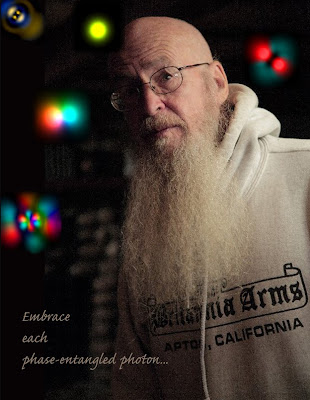 |
| Dinner Party chez Pierre and Mary Noyes: March 1988 |
However, Kaiser failed to mention that along with Berkeley's FFG, a like-minded group at Stanford (ANPA West, founded by Stanford professor Pierre Noyes), was also enthusiastically exploring the once disreputable field of quantum foundations. ANPA (an acronym for Alternative Natural Philosophy Association) was organized by Cambridge physicist Ted Bastin and his friends. The "bible" of ANPA was a collection of essays edited by Bastin Quantum Theory and Beyond which featured papers by David Bohm, Yakir Aharonov, Geoffrey Chew as well as lesser-known quantum-edge explorers). ANPA East was centered in Cambridge while its Western focus was Pierre's group at Stanford.
ANPA West meetings took place mainly in buildings in and around Stanford with an occasional trip into the redwoods to David McGoveran's house in Boulder Creek. The main focus of ANPA West was "bit-string physics"-- the world viewed as a computer program -- and attempting to calculate the value of fundamental constants via a technique called "combinatorial hierarchy". But a glance at the ANPA West Journal (a kitchen-table-top production by Tom Etter and Suzanne Bristol) shows that ANPA West members were also interested in other foundational topics including new quantum logics and Bell's Theorem. [Computer graphics wizard Dick Shoup has scanned and posted all these journals here.]
Physicist Henry Stapp (a prominent FFG member) has called Bell's Theorem "the most profound discovery in science". But despite its alleged profundity, this theorem was dismissed by the majority of physicists as "mere philosophy" and research into its implications was considered to be a "career breaker". For instance, John Clauser's advisor warned him, in effect, that he would never achieve an academic physics position if he persisted in doing a Bell's theorem experiment regarded at the time as an exercise in "mere philosophy".
Clauser's advisor was right -- John never did get an academic post -- but when Bell's theorem finally became fashionable in wider venues than Big Sur's Esalen Institute, Stanford's ANPA West and Berkeley's Fundamental Fyziks Group, John Clauser's trail-blazing work was belatedly recognized with one of the physics profession's highest honors.
Although I had corresponded with John Bell at CERN while writing Quantum Reality, I had never met the author of "the most profound discovery in science". I had one chance to meet Bell in 1982 when Saul-Paul Sirag and I invited him to Esalen Institute in Big Sur to receive (along with John Clauser), The Reality Prize, funded by Charles Brandon, one of the founders of FEDEX. It pleases me no end that of all the awards John Bell has since received (including a Nobel Prize nomination shortly before his untimely death in 1990 at age 62) our Esalen Reality Prize was the very first to publicly honor this extraordinary man. John Bell, however, did not come to Big Sur but instead sent a colleague, Bernard D'Espagnat, to accept the Reality Prize.
John Stewart Bell was my hero. I had spent a lot of time reading his papers, arguing with colleagues about his work and even developing my own bare-bones, stripped-down version of Bell's famous theorem. So you can imagine my delight when Pierre Noyes invited me to his home in the Stanford foothills for a seminar by John Bell and a few days later to a dinner party with John and his wife Mary Ross Bell, also a physicist. (This was in March 1988, only a few years before Bell's death.)
I recall very few details of that dinner in '88, except that for me it felt like sitting in an extra chair at Jesus's Last Supper. In John Bell's presence, I felt that close to holiness. One of the most charming aspects of John and Mary Bell was their Irish accents which lent a particular sparkle to their speech. Both John and Mary were brilliant, witty and entertaining. Our table talk was further enhanced by many many glasses of fine wine produced by Pierre's son David (proprietor of David Noyes Wines in Sonoma). Thank you, Pierre and Mary Noyes, for greatly enriching Nick and Betsy Herbert's lives.
Here's my favorite Bell story from those meetings. It took place in Pierre's living room in Bell's seminar a few days before the luminous dinner. In front of the black board, John Bell was arguing a particular point when a Stanford physicist loudly objected:
"But how can that be, John? Isn't such-and-such true?"
To which Bell replied (and you've got to imagine this delivered in a sparkling Irish accent):
"So ye believe such-and-such, do ye? Well. in three minutes, I'll have ye believin' the opposite."
And then, in less than three minutes, John Bell proceeded to make good his boast.







